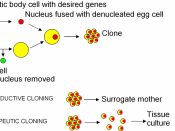A team of Scottish scientists produced the first live birth of a healthy sheep by cloned from an adult sheep. These scientists had established their works by transferring the nuclei from a donor sheep into the egg of another sheep. They scraped skin cells from the udder of a donor sheep and these cells were temporarily starved of nutrients to halt cell development. Then these scientists used an unfertilized egg was removed from a second sheep, and then they removed its nucleus to eliminate genetic characteristics of the egg. After that, they carefully transferred the starved cells from the first sheep containing a nucleus with genetic material into the unfertilized egg from second sheep. The eggs were cultured for a period before they implanted them into the uterus of third sheep to carry, and then one of the eggs will be culminated in a successfully birth. The embryo developed normally and was delivered safely.
Named Dolly, this healthy sheep was introduced to the world with many fanfares in February 1997.
Society as a whole can benefit from the techniques involving animal cloning. These include improved livestock herds, opportunities for research on disease, and production of protein enriched pharmaceuticals. Cloning can have many other important aspects that can be benefited for our society. For instance, zoo-technical importance, when an animal possesses an interesting level of milk production, cloning accelerates spreading of genetic progress. Basic aims, clones could understand better what is genetically fixed in an individual and what his characteristics are due to the environment. And to obtain genetically modified animals, animals are more uniform and therefore more useful in scientific research that could lead to a great benefit for our society. The creation of Dolly represents a unique advance for cloning technology, but it inevitably intensified the debate about subjecting...


